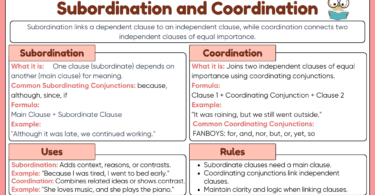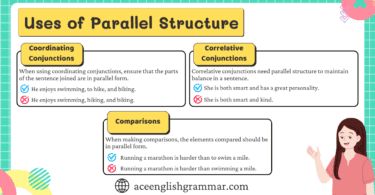A syllable is a single sound unit in a word, made up of one or more letters that form a vowel sound. Words can have one or many syllables, and knowing how to count them helps with pronunciation, spelling, and word stress. This post helps learn the types of syllables in English with simple rules and examples.
Table of Contents
What is a Syllable?
A syllable is a single unit of sound in a word, made up of one vowel sound with or without surrounding consonants.
For example:
- “Cat” has one syllable, pronounced /kat/.
- “Water” has two syllables, pronounced /waw-ter/.
- “Banana” has three syllables, pronounced /ba-nan-a/.
Components of Syllable
A syllable, in simple terms, has two main components:
- Vowel Sound: Every syllable has at least one vowel sound. It’s the part of the syllable where you hear the “a,” “e,” “i,” “o,” “u,” or sometimes “y” sound in a word. For example, in the word “cat,” the vowel sound is the “a.”
- Optional Consonant Sounds: Syllables can also have consonant sounds before or after the vowel sound. These are the other letters or sounds that accompany the vowel. In “cat,” the consonant sound before the vowel is “c,” and after the vowel is “t.”
Types of Syllables with Examples
Here are some basic types of syllables:
Open Syllables:
These syllables end with a vowel sound and do not have a consonant sound following the vowel. For example, “be” and “go.”
- me
- go
- hi
- so
- she
- he
- we
- why
- by
- pie
- be
Closed Syllables:
Closed syllables end with one or more consonant sounds following the vowel. For example, “cat” and “dog.”
- cat
- dog
- flip
- help
- pin
- stop
- swim
- thin
- wet
- ten
Vowel-Consonant-e (VCE) Syllables:
These syllables consist of a vowel followed by a consonant and then a silent “e.” The silent “e” changes the sound of the preceding vowel. For example, “cake” and “bone.”
- Cake
- Tube
- Bite
- Dune
- Care
- Angel
- Cube
- Fife
- Home
- Rose
Consonant-Vowel (CV) Syllables:
These syllables have a consonant sound followed by a vowel sound, like “me” and “so.”
- ma
- be
- hi
- so
- go
- le
- du
- mi
- ba
- to
Consonant-Vowel-Consonant (CVC) Syllables:
These syllables have a consonant sound followed by a vowel sound and then another consonant sound. For example, “cat” and “dog.”
- cat
- dog
- hat
- bed
- pig
- mom
- cup
- box
- bat
- top
Schwa Syllables:
The schwa is a very short, neutral vowel sound that occurs in unstressed syllables. It is often represented by the letter ‘a’ as in “sofa” or ‘e’ as in “bottle.”
- a’bove (uh-BOVE)
- veg’etable (VEJ-tuh-buhl)
- ac’cent (uhk-SENT)
- col’umn (kuh-LUHM)
- com’fortable (KUHM-fur-tuh-buhl)
- doc’ument (DAHK-yuh-muhnt)
- gov’ernment (GUHV-ern-muhnt)
- ev’ery (EV-uh-ree)
- or’ange (UHR-angj)
- sig’nificant (sig-NIF-uh-kuhnt)
Complex Syllables:
Some syllables may have combinations of the above types, making them more complex. For example, “happily” has a closed syllable “hap,” followed by an open syllable “pi,” and ending with a vowel-consonant-e syllable “ly.”
- Conspire – con-spire
- Hospital – hos-pi-tal
- Apartment – a-part-ment
- University – u-ni-ver-si-ty
- Exhale – ex-hale
- Animal – an-i-mal
- Realize – re-a-lize
- Dialogue – di-a-logue
- Fabricate – fab-ri-cate
- Necessary – ne-ces-sa-ry
Stressed and Unstressed Syllable:
In many words, especially longer ones, some syllables are pronounced with more emphasis (stressed), while others are pronounced more lightly (unstressed). For example, the word “syllable” has stress on the first syllable (SYL), and the second syllable “la” and the last syllable “ble” are unstressed and pronounced quickly and quietly.
- MU-sic
- HAP-py
- WIN-dow
- CHOC-o-late
- FA-mous
- im-POR-tant
- HOS-pi-tal
- compu-TER
- BEAU-ti-ful
- OC-to-ber
Why syllables are important?
- Syllables are important because they are the building blocks of words.
- They help you say words correctly, breaking them into smaller parts that are easier to pronounce.
- Understanding syllables can make it easier to learn new words. When you know how to break a word into syllables, it becomes simpler to recognize and remember its meaning.
- Understanding syllables can help with spelling. You can spell a word more accurately when you know how many syllables it has.
- When you know how to break words into syllables, you can write more clearly and avoid spelling mistakes.
- Learning syllables can improve your speaking fluency, as it helps you speak more smoothly and naturally.
- Recognizing syllables helps improve reading fluency as it enables learners to decode longer and unfamiliar words and understand their pronunciation.
- Syllables help you understand where to put emphasis when speaking, For example, in “RE-cord” (noun), the stress is on the first syllable, but in “re-CORD” (verb), the stress is on the second syllable. Understanding syllables helps you convey the right meaning through correct stress placement.
How to identify syllables?
Here are some basic points for identifying syllables:
- Listen: Pay attention to the sounds in a word.
- Count: Identify each separate beat or sound in the word.
- Vowels: Focus on vowels (A, E, I, O, U, Y) as they often form the nucleus of syllables.
- Consonants: Look for consonants that surround the vowels within a word.
- Clapping: Clap your hands or tap your fingers to mark each syllable.
- Practice: Practice syllable counting with different words to improve your skills.
- Divide Carefully: Split the word where it naturally breaks into sounds.
Examples of Syllable:
- Cat: One syllable (kat)
- Elephant: Three syllables (el-e-phant)
- Happiness: Three syllables (hap-pi-ness)
- Universe: Three syllables (u-ni-verse)
- Watermelon: Four syllables (wa-ter-mel-on)
- Computer: Three syllables (com-pu-ter)
- Water: “wa-ter” (2 syllables)
- Examination: Four syllables (ex-am-i-na-tion)
- Breakfast: Two syllables (break-fast)
- Incredible: Four syllables (in-cred-i-ble)
- Hospital: Three syllables (hos-pi-tal)
- Delightful: Three syllables (De-light-ful).
- Interesting: Four syllables (In-ter-est-ing).
- Refrigerator: Five syllables (Re-frig-er-a-tor).
- Unbelievable: Five syllables (Un-be-liev-a-ble)
FAQs
Q1: What is a syllable?
A syllable is a unit of sound in a word that contains a single vowel sound and may include one or more consonants.
Q2: Why are syllables important?
Syllables are important for pronunciation, spelling, and reading. They help us break words into manageable parts, improve our pronunciation, and understand word structure.
Q3: How do you count syllables in a word?
You can count syllables by listening for the beats or rhythm in a word, clapping or tapping for each beat, and looking for vowel sounds surrounded by consonants.
Q4: What is the difference between open and closed syllables?
An open syllable ends with a vowel sound (e.g., “go” or “hi”), while a closed syllable ends with a consonant sound (e.g., “cat” or “sit”).
Q5: Do syllables affect word stress and pronunciation?
Yes, the number and placement of syllables in a word can influence word stress and pronunciation. Stressed syllables are typically pronounced more prominently than unstressed ones.
Q6: Give examples of one-syllable words?
Examples of one-syllable words include “dog,” “cat,” “pen,” and “sit.”
Read More




Leave a Comment